Performance Comparison of 500 MW Coal-Fired Thermal Power Plants with Final Feedwater Temperatures
Abstract
:1. Introduction
2. Materials and Methods
2.1. Regenerative-Reheat Rankine Cycle
2.1.1. Typical Coal-Fired Power Plant
2.1.2. Final Feedwater Temperature
2.2. Performance Analysis of the Steam Cycle
2.2.1. Theories of Analysis
2.2.2. Design Conditions and Interpretation
3. Results and Discussion
3.1. Final Feedwater Temperature and Feedwater System
3.2. Condensate Water System
3.3. Exergy Destruction Rate of Power Plant
3.4. Gross Output, Net Output, and Net Efficiency of Power Plant
4. Conclusions
Author Contributions
Funding
Institutional Review Board Statement
Informed Consent Statement
Data Availability Statement
Conflicts of Interest
References
- UNFCCC. Adoption of the Paris Agreement. 2015. Available online: https://unfccc.int/resource/docs/2015/cop21/eng/l09r01.pdf (accessed on 15 January 2022).
- Gi, K.; Sano, F.; Akimoto, K.; Hiwatari, R.; Tobita, K. Potential contribution of fusion power generation to low-carbon development under the Paris Agreement and associated uncertainties. Energy Strategy Rev. 2020, 27, 100432. [Google Scholar] [CrossRef]
- Chang, S.H.; Kim, B.S.; Min, T.K. Development of Ultra-Supercritical (USC) Power Plant. Trans. Korean Soc. Mech. Eng. 2012, 36, 205–210. [Google Scholar] [CrossRef]
- Song, B.H. 500MW class standard coal-fired retrofit demonstration project. J. KSME 2015, 55, 41–44. [Google Scholar]
- Kim, S. Decomposition Analysis on GHG Emissions of Domestic Electricity Generation Sector. Korean Energy Econ. Rev. 2018, 17, 241–264. [Google Scholar]
- Korea Energy Economics Institution. Yearbook of Energy Statistics 2021. 2022. Available online: http://www.keei.re.kr/keei/download/YES2021.pdf (accessed on 21 February 2022).
- Roh, J.Y.; Kang, S.M.; Lee, H.S.; Jeon, E.C. CO2 Reduction Potential due to Expansion of Ultra Super-Critical Power Plants. J. Clim. Change Res. 2020, 11, 713–717. [Google Scholar] [CrossRef]
- Rukes, B.; Taud, R. Status and perspectives of fossil power generation. Energy 2004, 29, 1853–1874. [Google Scholar] [CrossRef]
- Li, Y.; Zhou, L.; Xu, G.; Fang, Y.; Zhao, S.; Yang, Y. Thermodynamic analysis and optimization of a double reheat system in an ultra-supercritical power plant. Energy 2014, 74, 202–214. [Google Scholar] [CrossRef]
- Yang, Y.; Wang, L.; Dong, C.; Xu, G.; Morosuk, T.; Tsatsaronis, G. Comprehensive exergy-based evaluation and parametric study of a coal-fired ultra-supercritical power plant. Appl. Energy 2013, 112, 1087–1099. [Google Scholar] [CrossRef]
- Bugge, J.; Kjaer, S.; Blum, R. High-efficiency coal-fired power plants development and perspectives. Energy 2006, 31, 1437–1445. [Google Scholar] [CrossRef]
- Beer, J.M. High efficiency electric power generation: The environmental role. Prog. Energy Combust. Sci. 2007, 33, 107–134. [Google Scholar] [CrossRef]
- Weitzel, P.S. Steam generator for advanced ultra-supercritical power plants 700 to 760c. In Proceedings of the ASME Power Conference, Denver, CO, USA, 12–14 July 2011; pp. 281–291. [Google Scholar] [CrossRef]
- Stepczynska, K.; Kowalczyk, Ł.; Dykas, S.W. Elsner, Calculation of a 900 MW conceptual 700/720 °C coal-fired power unit with an auxiliary extraction-backpressure turbine. J. Power Technol. 2012, 92, 266–273. [Google Scholar]
- Łukowicz, H.; Dykas, S.; Rulik, S.; Stępczyńska, K. Thermodynamic and economic analysis of a 900 MW ultrasupercritical power unit. Arch. Thermodyn. 2011, 32, 231–244. [Google Scholar] [CrossRef]
- Espatolero, S.; Cortos, C.; Romeo, L.M. Optimization of boiler cold-end and integration with the steam cycle in supercritical units. Appl. Energy 2010, 87, 1651–1660. [Google Scholar] [CrossRef]
- Salih, W.A.; Alkumait, A.A.; Khalaf, H.J. Energy and exergy assessment of north refineries company (NRC) steam cycle based on air mass flowrate of main condenser. Tikrit J. Eng. Sci. 2021, 28, 61–70. [Google Scholar] [CrossRef]
- Espatolero, S.; Romeo, L.M.; Cortes, C. Efficiency improvement strategies for the feedwater heaters network designing in supercritical coal-fired power plants. Appl. Therm. Eng. 2014, 73, 449–460. [Google Scholar] [CrossRef]
- Srinivas, T.; Gupta, A.V.S.S.K.S.; Reddy, B. Generalized Thermodynamic Analysis of Steam Power Cycles with ‘n’ Number of Feedwater Heaters. Int. J. Thermodyn. 2007, 10, 177–185. [Google Scholar]
- Mohammed, M.K.; Al Doori, W.H.; Jassim, A.H.; Ibrahim, T.K.; Al-Sammarraie, A.T. Energy and exergy analysis of the steam power plant based on effect the numbers of feed water heater. J. Adv. Res. Fluid Mech. Therm. Sci. 2019, 56, 211–222. [Google Scholar]
- Khaleel, O.J.; Ibrahim, T.K.; Ismail, F.B.; Al-Sammarraie, A.T.; bin Abu Hassan, S.H. Modeling and analysis of optimal performance of a coal-fired power plant based on exergy evaluation. Energy Rep. 2022, 8, 2179–2199. [Google Scholar] [CrossRef]
- Khaleel, O.J.; Ibrahim, T.K.; Ismail, F.B.; Hassan, S.H.A. Thermal performance of coal-fired power plant based on number of feedwater heaters. J. Adv. Res. Fluid Mech. Therm. Sci. 2022, 95, 188–205. [Google Scholar] [CrossRef]
- Khaleel, O.J.; Ibrahim, T.K.; Ismail, F.B.; Al-Sammarraie, A.T. Developing an analytical model to predict the energy and exergy based performances of a coal-fired thermal power plant. Case Stud. Therm. Eng. 2021, 28, 101519. [Google Scholar] [CrossRef]
- Ust, Y.; Gonca, G.; Kayadelen, H.K. Determination of optimum reheat pressures for single and double reheat irreversible Rankine cycle. J. Energy Inst. 2011, 84, 215–219. [Google Scholar] [CrossRef]
- Rashidi, M.M.; Aghagoli, A.; Ali, M. Thermodynamic Analysis of a Steam Power Plant with Double Reheat and Feedwater Heaters. Adv. Mech. Eng. 2014, 6, 940818. [Google Scholar] [CrossRef]
- Habib, M.A.; Zubair, S.M. Second law-based thermodynamic analysis of regenerative-reheat Rankine-cycle power plants. Energy 1992, 17, 295–301. [Google Scholar] [CrossRef]
- Dincer, I.; Al-Muslim, H. Thermodynamic analysis of reheat cycle steam power plants. Int. J. Energy Res. 2001, 25, 727–739. [Google Scholar] [CrossRef]
- Habib, M.A.; Said, S.A.M.; Al-Zaharna, I. Optimization of reheat pressures in thermal power plants. Energy 1995, 20, 555–565. [Google Scholar] [CrossRef]
- Habib, M.A.; Said, S.A.M.; Al-Zaharna, I. Optimization Thermodynamic optimization of reheat regenerative thermal-power plants. Appl. Energy 1999, 63, 17–34. [Google Scholar] [CrossRef]
- Sengupta, S.; Datta, A.; Duttagupta, S. Exergy analysis of a coal-based 210MW thermal power plant. Int. J. Energy Res. 2007, 31, 14–28. [Google Scholar] [CrossRef]
- Khaleel, O.J.; Ismail, F.B.; Ibrahim, T.K.; bin Abu Hassan, S.H. Energy and exergy analysis of the steam power plants: A comprehensive review on the Classification, Development, Improvements, and configurations. Ain Shams Eng. J. 2022, 13, 101640. [Google Scholar] [CrossRef]
- Khaleel, O.J.; Ismail, F.B.; Ibrahim, T.K. Parametric assessment of the thermal performance of coal-fired power plant. J. Adv. Res. Fluid Mech. Therm. Sci. 2021, 87, 27–43. [Google Scholar] [CrossRef]
- Reddy, V.S.; Kaushik, S.C.; Tyagi, S.K. Exergetic analysis of solar concentrator aided coal fired super critical thermal power plant (SACSCTPT). Clean Technol. Environ. Policy 2013, 15, 133–145. [Google Scholar] [CrossRef]
- Yang, Y.; Yan, Q.; Zhai, R.; Kouzani, A.; Hu, E. An efficient way to use medium-or-low temperature solar heat for power generation–integration into conventional power plant. Appl. Therm. Eng. 2011, 31, 157–162. [Google Scholar] [CrossRef]
- Hu, E.; Yang, Y.; Nishimura, A.; Yilmaz, F.; Kouzani, A. Solar thermal aided power generation. Appl. Energy 2010, 87, 2881–2885. [Google Scholar] [CrossRef]
- Gupta, M.K.; Kaushik, S.C. Exergetic utilization of solar energy for feedwater preheating in a conventional thermal power plant. Int. J. Energy Res. 2009, 33, 593–604. [Google Scholar] [CrossRef]
- Popov, D. An option for solar thermal repowering of fossil fuel fired power plants. Sol. Energy 2011, 85, 344–349. [Google Scholar] [CrossRef]
- Moran, M.J.; Shapiro, H.N. Fundamentals of Engineering Thermodynamics; John Wiley & Sons: Hoboken, NJ, USA, 2000. [Google Scholar]
- Ro, S.T. Engineering Thermodynamics; Munundang: Seoul, Republic of Korea, 2012. [Google Scholar]
- Noroozian, A.; Mohammadi, A.; Bidi, M.; Ahmadi, M.H. Energy, exergy and economic analyses of a novel system to recover waste heat and water in steam power plants. Energy Convers. Manag. 2017, 144, 351–360. [Google Scholar] [CrossRef]
- Korea Electric Power Corporation. Statistics of Electric Power in Korea 2023. 2024. Available online: https://home.kepco.co.kr/kepco/cmmn/documentViewer.po?fn=BBS_202406171041028251&rs=/kepco/synap/doc (accessed on 13 July 2024).
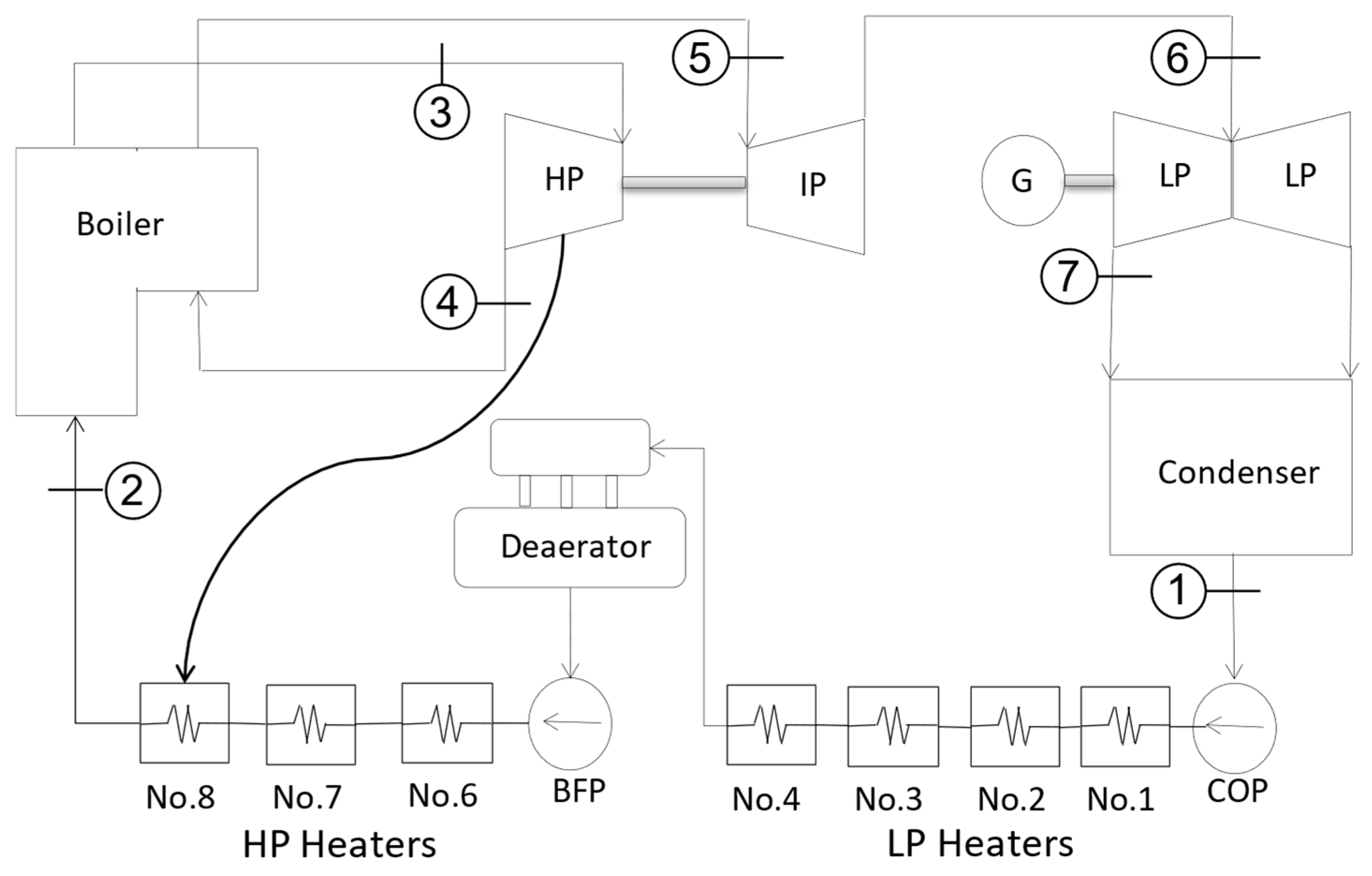

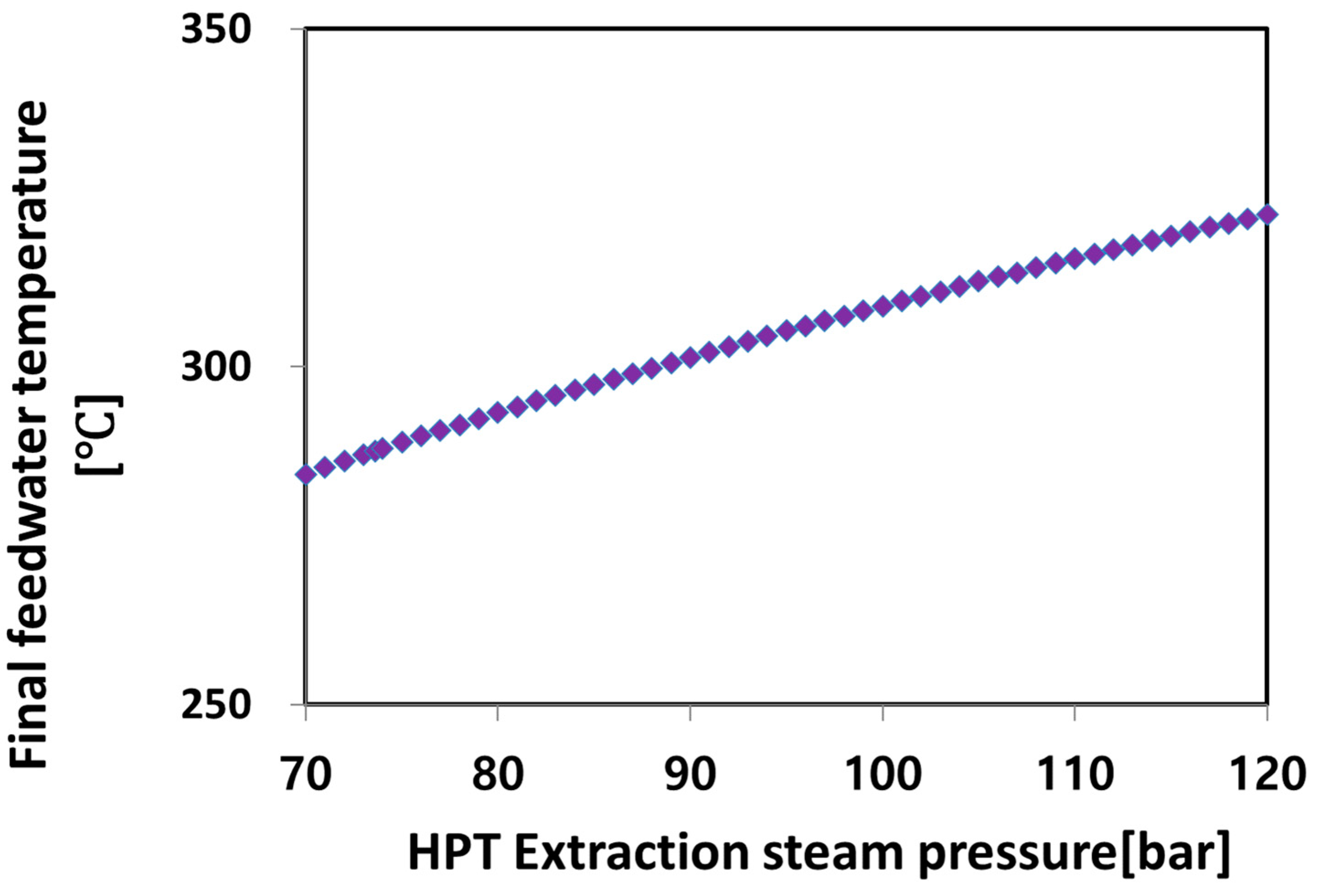
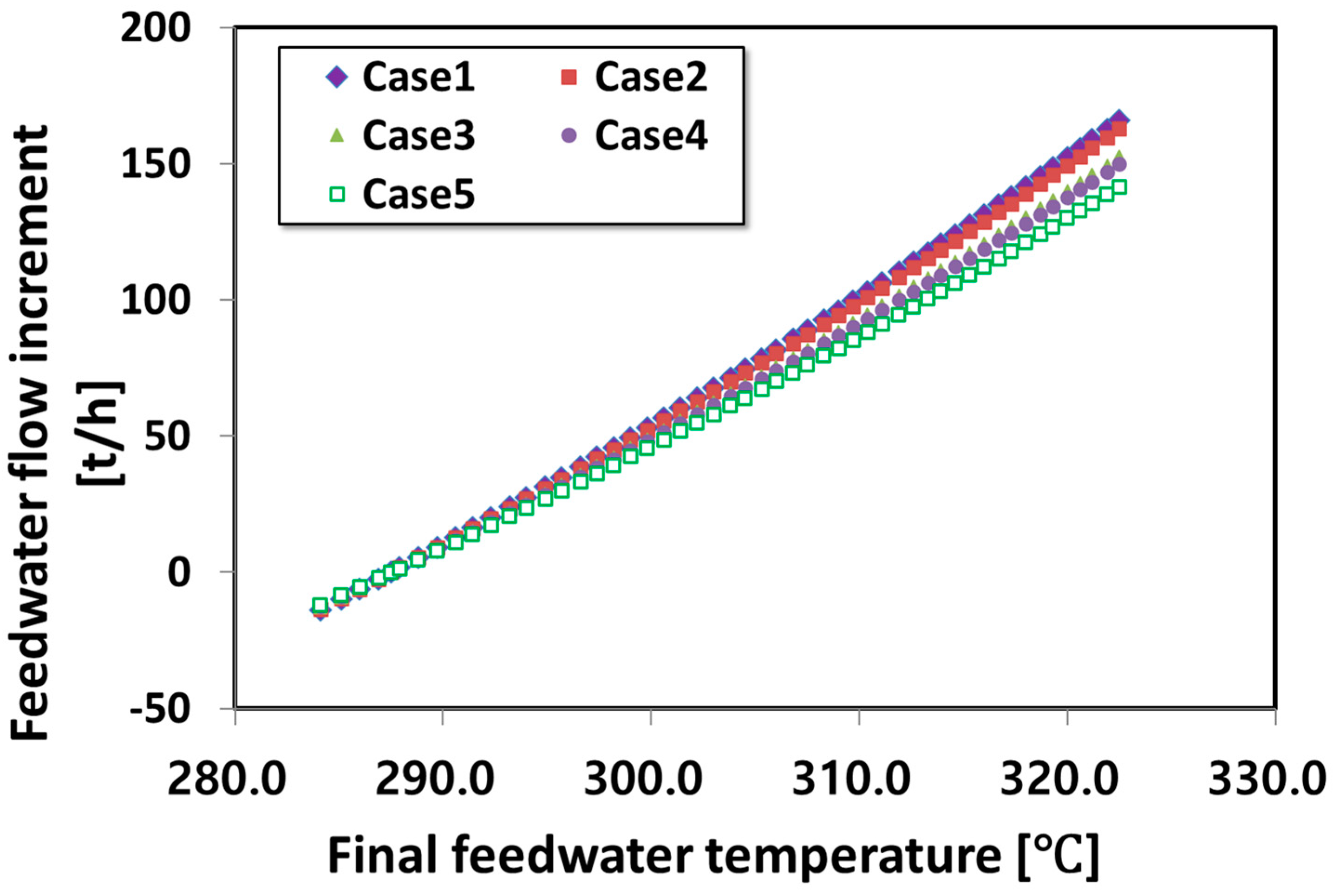
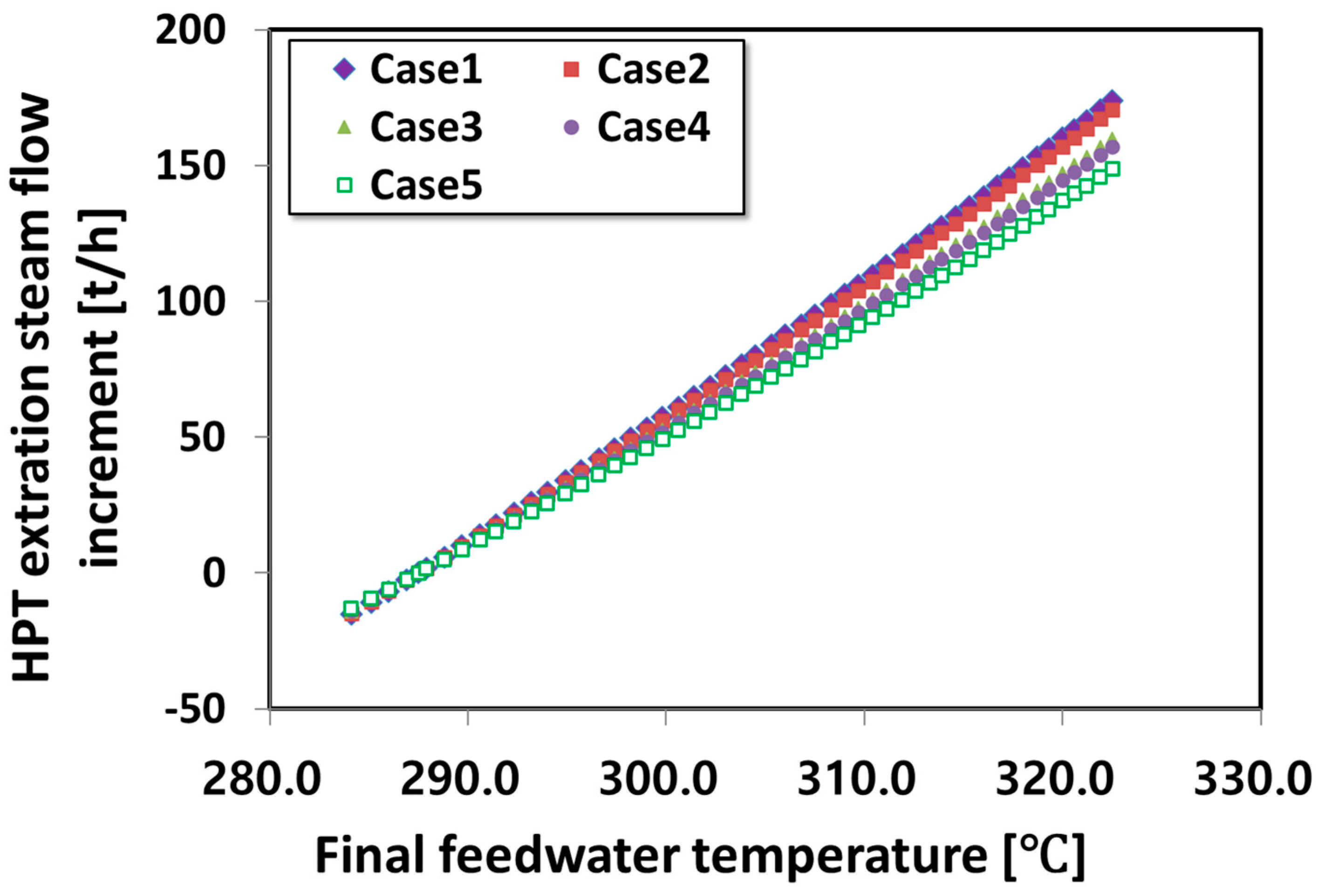
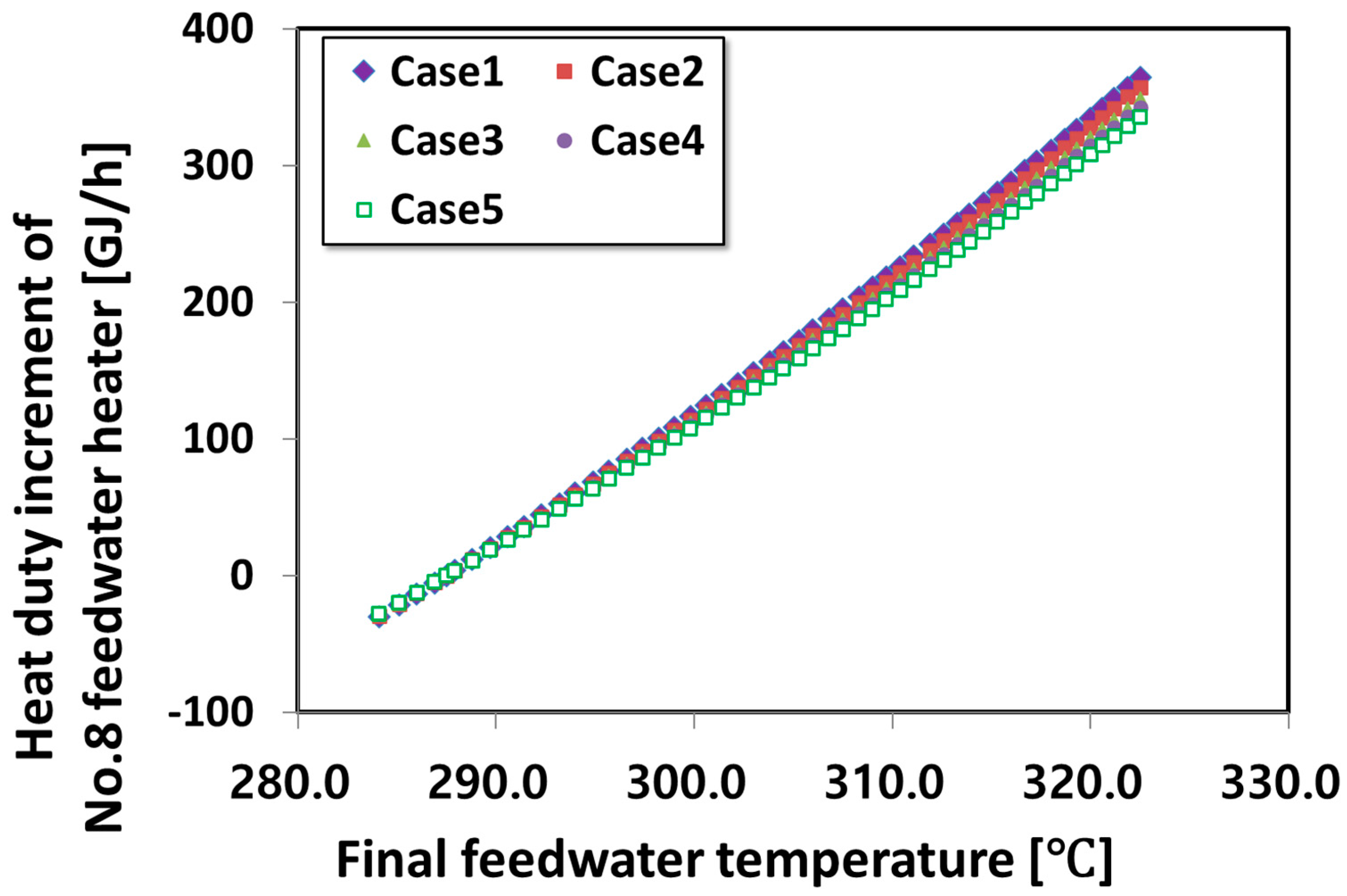
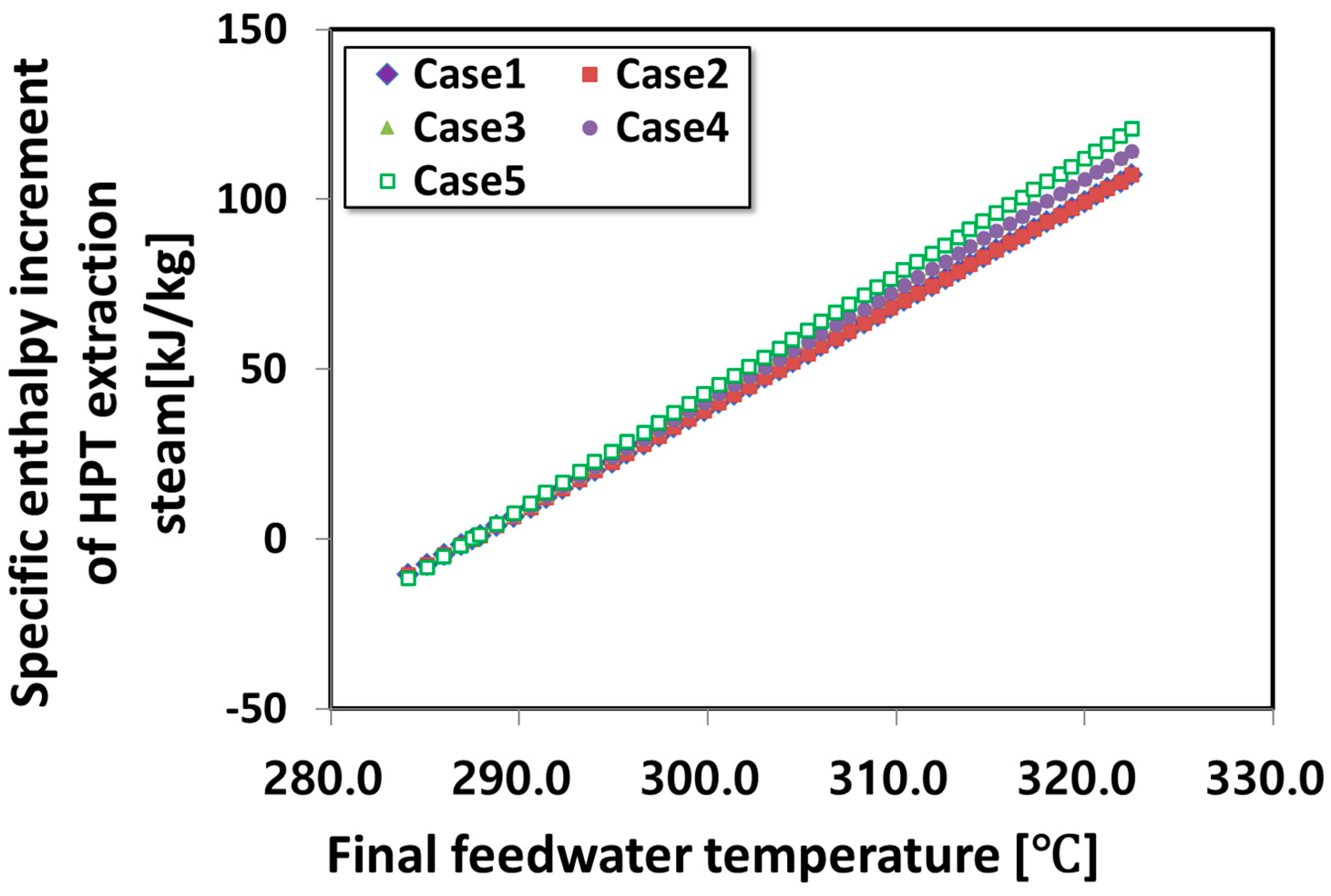




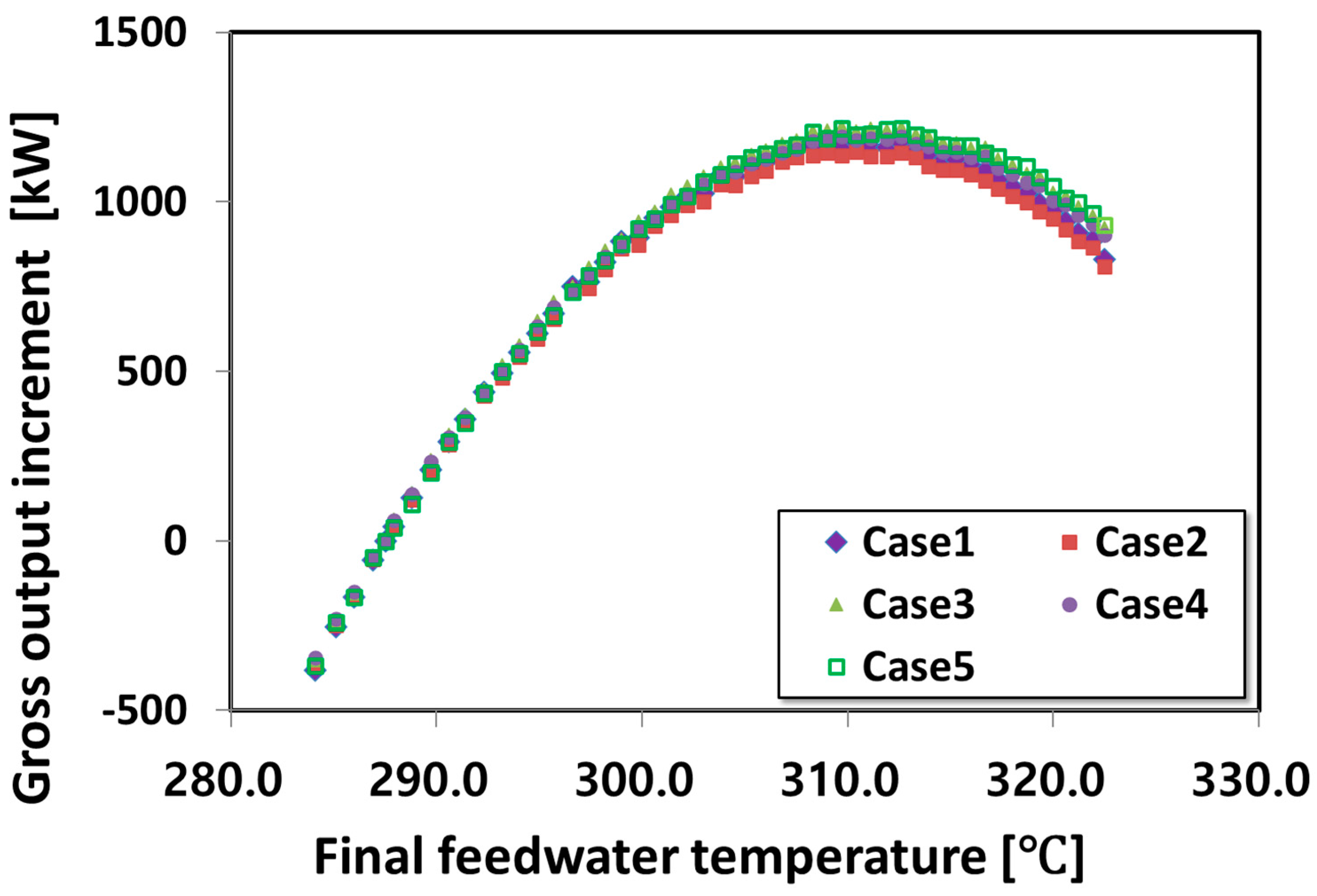

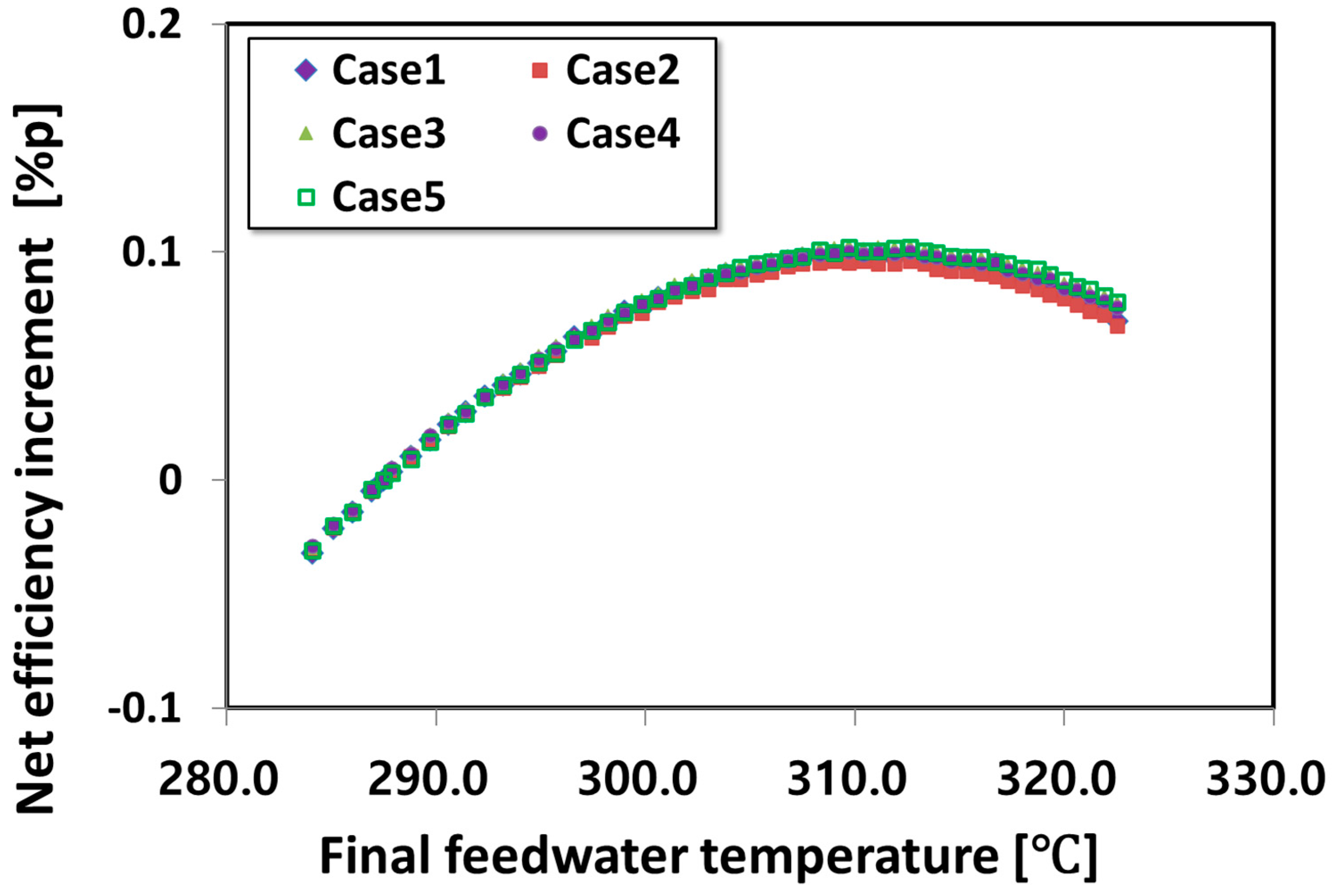
| Item | Conditions |
|---|---|
| Final feedwater temperature | 287.5 °C |
| Heat transfer rate of the boiler | 1,195,197 kJ/s |
| Exhaust pressure of low-pressure turbine | 5.1 kPa |
| Isentropic efficiency of condensate pump | 80% |
| Efficiency of condensate pump motor | 95% |
| Main Steam Pressure (bar) | Main Steam Temperature (°C) | Hot Reheat Steam Temperature (°C) | |
|---|---|---|---|
| Case 1 | 242.33 | 537.8 | 537.8 |
| Case 2 | 242.33 | 537.8 | 566 |
| Case 3 | 242.33 | 566 | 566 |
| Case 4 | 242.33 | 566 | 593 |
| Case 5 | 242.33 | 593 | 593 |
| Net Output Increment Ratio (kW/°C) 1 | Net Efficiency Increment Ratio (%p/°C) 1 | |
|---|---|---|
| Case 1 | 63.05 | 0.00528 |
| Case 2 | 61.50 | 0.00515 |
| Case 3 | 63.99 | 0.00535 |
| Case 4 | 62.49 | 0.00523 |
| Case 5 | 64.06 | 0.00536 |
| Average | 63.02 | 0.00527 |
Disclaimer/Publisher’s Note: The statements, opinions and data contained in all publications are solely those of the individual author(s) and contributor(s) and not of MDPI and/or the editor(s). MDPI and/or the editor(s) disclaim responsibility for any injury to people or property resulting from any ideas, methods, instructions or products referred to in the content. |
© 2024 by the authors. Licensee MDPI, Basel, Switzerland. This article is an open access article distributed under the terms and conditions of the Creative Commons Attribution (CC BY) license (https://creativecommons.org/licenses/by/4.0/).
Share and Cite
Jang, Y.-C.; Moon, S.-J. Performance Comparison of 500 MW Coal-Fired Thermal Power Plants with Final Feedwater Temperatures. Appl. Sci. 2024, 14, 6999. https://doi.org/10.3390/app14166999
Jang Y-C, Moon S-J. Performance Comparison of 500 MW Coal-Fired Thermal Power Plants with Final Feedwater Temperatures. Applied Sciences. 2024; 14(16):6999. https://doi.org/10.3390/app14166999
Chicago/Turabian StyleJang, Yong-Chu, and Seung-Jae Moon. 2024. "Performance Comparison of 500 MW Coal-Fired Thermal Power Plants with Final Feedwater Temperatures" Applied Sciences 14, no. 16: 6999. https://doi.org/10.3390/app14166999






